|
|
|
Sort Order |
|
|
|
Items / Page
|
|
|
|
|
|
|
| Srl | Item |
| 1 |
ID:
152970


|
|
|
|
|
| Summary/Abstract |
Infrastructure developments across the trans-Himalaya have rapidly advanced Nepali and Chinese state presences across spaces where central governance has long been absent. This study examines how new border infrastructures of fences and roads shape commercial and cultural relationships between Mustang (Nepal) and Tibet and the ways in which these processes serve state-making purposes for both Nepal and China through the governance of highland–borderland landscapes. A Tibetan cultural region at Nepal's northern border, Mustang's human and physical geography supports trade corridors that link the Tibetan Plateau with the plains of India. Merchants, mendicants and militaries have traversed these trade routes for centuries, giving rise to a unique social landscape that largely transcends modern demarcations of a bordered world. Looking across the trans-Himalaya, this article argues that as Chinese and Nepali authorities introduce new material structures and institutional practices to regulate and solidify the border between Tibet and Mustang, local communities are alternatively oriented towards either Kathmandu or Beijing under shifting terms of economic and political power.
|
|
|
|
|
|
|
|
|
|
|
|
|
|
|
|
| 2 |
ID:
193616
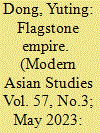

|
|
|
|
|
| Summary/Abstract |
This article investigates Japanese imperialism in northeast China through its road construction infrastructure projects within its railway auxiliary zone (1906–1932) and Manchuria at large (1932–1945). The materiality of roads unveils a history of how Japanese engineers adapted to local practices and absorbed local knowledge in building physical infrastructure and developing their technical expertise. These engineers engaged with local practices rooted in pre-existing social and natural environments to facilitate road construction. At the same time, in Manchuria their technical expertise in construction was built on the absorption and subsequent erasure of local workers’ vernacular craft. Rather than the physical realization of an imperialist, top-down vision of modernization, imperial infrastructure projects were in fact hybrid productions of technical expertise, and local vernacular knowledge and skills. By constructing roads, engineers helped to expand Japan’s political and economic influence in northeast China, assert domination over Chinese residential areas and business interests, and coerce Chinese subjects into complying with policies and rules issued by Japanese administrations. The materials of roads—gravel, granite flagstone, and concrete—illustrate a complex relationship between Japanese imperial agents and local environments.
|
|
|
|
|
|
|
|
|
|
|
|
|
|
|
|
| 3 |
ID:
185924
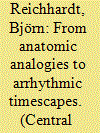

|
|
|
|
|
| Summary/Abstract |
This paper is concerned with the intertwinement of the timescapes of roads and rural life within the context of infrastructural development in northern Mongolia’s Khövsgöl region. With reference to ethnographic fieldwork, it explores how visions of incorporating roads into state development conflict with the landscapes and temporalities these very roads cross. By looking at infrastructural promise formulated in phrases such as ‘development follows the road’, this paper investigates what happens at the end of the road that connects Khatgal, a touristic village, with the provincial centre Mörön and the capital Ulaanbaatar. In this context, anatomic analogies are questioned as a leitmotif for road construction. In concert with the notion of timescapes, anatomic analogies offer a useful tool to critically analyse the spatial and temporal entanglements of infrastructural development in Mongolia.
|
|
|
|
|
|
|
|
|
|
|
|
|
|
|
|
| 4 |
ID:
088013
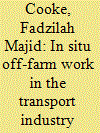

|
|
|
|
|
| Publication |
2009.
|
| Summary/Abstract |
This paper examines the informal transport sector within the smallholder oil palm economies of Kinabatangan and Lahad Datu areas of eastern Sabah by looking at the metaphoric border that is constructed between licit and illegal activities that take place on roads. It describes the work of two groups of drivers, namely, those who are themselves smallholders who provide a crucial service to the community in getting their fresh fruit bunches to mills on time; and the piret (pirate) taxis who transport passengers including foreign nationals, some of whom are illegal workers. Many have been driving for some time, thereby challenging the notion about off-farm work as providing a temporary safety net to smallholders. Drivers whose permits may be current may have used illegal means (such as meminggir - logging without licence), to accumulate the initial funds for acquiring their vehicles and necessary permits. Moreover, their clients are unconcerned about their 'illegal' status. Consequently, this paper maintains that there is no agreed-upon norms about legality/illegality, and law enforcement being uneven, the zone in which drivers operate is a fluid one.
|
|
|
|
|
|
|
|
|
|
|
|
|
|
|
|
| 5 |
ID:
147837
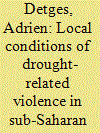

|
|
|
|
|
| Summary/Abstract |
Despite growing concerns about the possible security implications of extreme precipitation shortfalls in vulnerable and politically fragile regions, the particular conditions that make armed violence more or less likely in times of drought remain poorly understood. Using a spatially disaggregated research design and focusing on sub-Saharan Africa, the present analysis assesses how far violent and nonviolent outcomes in the wake of drought can be accounted for by regional differences in the provision of key infrastructures that help coping with drought and preventing violence. The results indicate that civil conflict events in connection with drought are more likely in administrative areas with poorly developed road infrastructures. Drought-related communal violence, on the other hand, is more likely in regions where an important part of the population lacks access to an improved water source. Thus, while the provision of key infrastructures seems to moderate local conflict risks in connection with drought, there are nevertheless important distinctions with regard to different types of infrastructures and forms of armed violence. However, the importance of precipitation shortfalls as a conflict-facilitating factor in sub-Saharan Africa should not be overstated, as the overall contribution of drought measures to predicting violent events is modest in all calculated models.
|
|
|
|
|
|
|
|
|
|
|
|
|
|
|
|
| 6 |
ID:
178155
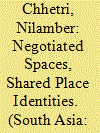

|
|
|
|
|
| Summary/Abstract |
Succeeding waves of mobilisation for the separate state of Gorkhaland has left an indelible imprint on the cultural, political and urban landscape of the Darjeeling Hills. Based on empirical research, this paper tries to explore the intricate relationship between ethnicity, place and politics of belonging in the Himalayan town of Kalimpong. It specifically tries to locate the interface between political events and the transformation of the urban landscape by taking into consideration the growth of roadside settlements. While noting the specific contours of these settlements, their culture and their liminal condition, the paper tries to address the issues pertaining to place-making and identity formation in the Himalayan region.
|
|
|
|
|
|
|
|
|
|
|
|
|
|
|
|
| 7 |
ID:
129524
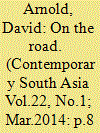

|
|
|
|
|
| Publication |
2014.
|
| Summary/Abstract |
Taking early nineteenth-century European travel narratives as its point of entry, this article suggests ways in which the subject of roads in India can be more fully addressed. Rather than regarding them as purely a means of circulation (of goods, ideas and personnel), roads can be interpreted as a manifestation of linear modes of power and, for Europeans and Indians alike under colonial rule, as a salient site of social observation, engagement and friction. Roads constitute an underappreciated site of social interaction - voluntarily, perhaps, as among pilgrims and other travellers, but also, at the other extreme, through the contrived sociability of individuals' intent on deception and theft. Roads were subject to coercive forms of social interaction as with convicts and famine relief workers obliged to labour on their construction and repair. Roads provided routes to new social locations, but also avenues for political display and ideological intervention and for the articulation of new technologies of social control and state action. Although this article's approach is primarily historical, it suggests ways in which the subject of roads might be of wider interdisciplinary interest and more contemporary significance.
|
|
|
|
|
|
|
|
|
|
|
|
|
|
|
|
| 8 |
ID:
174792
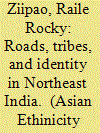

|
|
|
|
|
| Summary/Abstract |
Along with military expeditions and social and anthropological surveys, road-building projects were prominent strategies of the British in India when it came to dealing with tribes and territorialization of the frontier regions. Roads for territorial expansion and resource extraction were the core agenda of the colonial project in Northeast India. The post-colonial Indian state on the other hand built roads in the region for securing the borders, promoting national integration, and linking external markets. This article posits that road building has always been an act of power, which has at different times been aimed at smoothening relationships, securing borders, (dis)connecting people, enabling trade, creating spaces of contestation, or diluting boundaries between varied ethnic groups. The article analyzed the colonial state-making project through road construction and linked to the contemporary Indian state approach to infrastructure development in tribal-dominated areas of Northeast India.
|
|
|
|
|
|
|
|
|
|
|
|
|
|
|
|
| 9 |
ID:
171299


|
|
|
|
|
| Summary/Abstract |
There has been a resurgence of recreational cycling in Mumbai, as elsewhere in India, since the early 2010s. A significant reason for the new popularity of cycling has to do with the immersion in the urban landscape that it offers; people are attracted by the pleasures of the embodied experiences of cycling as well as interactions with the varied communities of cyclists with whom they share the road. This paper shows how surfaces matter both materially and metaphorically in opening new possibilities for understanding fun, recreation and pleasure. Whereas in critical urban studies and related fields, surface often connotes superficiality or a cover over the real, I argue that attention to surfaces and its pleasures is what enables people to emphasise the productive possibilities of ‘convivial alliances’ across differences and to promote an agenda for sustainable transportation politics that goes beyond infrastructure building.
|
|
|
|
|
|
|
|
|
|
|
|
|
|
|
|
| 10 |
ID:
185922
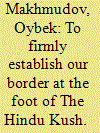

|
|
|
|
|
| Summary/Abstract |
Expansion has been a trait typical of many empires. As they occupied new territories, empires needed to exert control over them, and for this they needed roads. New roads also served to indirectly legitimize imperial rule over subjugated lands, in the eyes of both the local population and other, competing colonial powers. The Russian Empire was no exception, especially in such remote, mountainous regions as Pamir. As soon as Russian rule had been established, the Russian authorities faced the challenge here of ‘developing’ the road network. Roadbuilding, initiated by the Russians, brought the technological advances of the West to the peoples living in the Pamir Mountains, and accelerated their integration with the rest of the empire, whilst simultaneously legitimizing Russian rule at a local level. Traditional, local trails and Russian-built roads merged into a single network, an imperial mix of communication lines that allowed the Russians to successfully control Pamir.
|
|
|
|
|
|
|
|
|
|
|
|
|
|
|
|
| 11 |
ID:
185923


|
|
|
|
|
| Summary/Abstract |
In this article we discuss how infrastructural connections – here the ‘northbound’ and ‘southbound’ sections of a transregional road crossing the mountainous district of Toghuz-Toro in central Kyrgyzstan – become sites where identities can be either confirmed or contested. Linking this district with places that figure prominently in the symbolic geography of Kyrgyzstan, which divides the country into North and South, the two sections of road are inherently enmeshed in regional identity politics. Further, the article considers how the inhabitants of Toghuz-Toro take care of their own mobility and preserve desired connections in a harsh terrain, in the absence of state-managed public transport, and in a situation that sees only rudimentary road maintenance. It shows that technologies such as mobile Internet, and social media such as Facebook, have engendered a profound transformation in the use of transport infrastructure, breathing new life into journeys along the old, dilapidated post-Soviet roads.
|
|
|
|
|
|
|
|
|
|
|
|
|
|
|
|
|
|
|
|
|